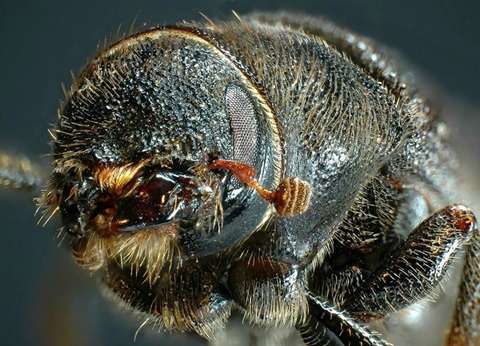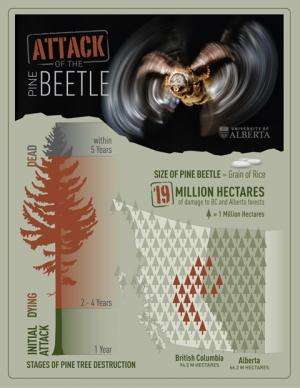The mountain pine beetle Credit: Ward Strong, B.C. Ministry of Forests, Lands, and Natural Resource Operations
When the mountain pine beetle began blazing a path across forests in British Columbia and Alberta, nobody could have imagined the extent of the damage to come. But as the insect devastated pine forests and disrupted communities, forest industries, recreational use, watersheds, and plant and wildlife habitats, the problem became disturbingly clear. Now, as the beetle creeps into the boreal forests of the Northwest Territories and Saskatchewan, with a real concern it may reach as far east as the Maritime provinces, researchers at the University of Alberta have responded to calls from government, industry, non-profit organizations and the general public to help conserve and protect an invaluable national resource at the heart of Canadian identity.
The ecology of surprise
Janice Cooke dubs it the "ecology of surprise."
Cooke, a researcher in the Department of Biological Sciences, is director of TRIA-Net, a national collaboration of 18 scientists (including six from the University of Alberta), government forestry officers, and representatives from industry and the not-for-profit sector. The new network is the third phase of the Tria Project, which was formed in 2007 to get research results to the front lines where they can be used in the fight to control the spread of the mountain pine beetle.
One of a handful of Canadian researchers studying the beetle as it blazes a path through Canada's pine forests, Cooke, fellow University of Alberta scientists and other national partners have rapidly accepted that today's knowledge may not be enough to answer tomorrow's questions about the minuscule but destructive bug.
"We are having to adapt to what the beetle throws us, responding to the evolving developments of the outbreak and filling the knowledge gaps," she says. "Mountain pine beetle is such an enormously complex problem, it requires a fundamentally different approach to create the new knowledge that is vital to controlling the spread of the beetle."
For Lorne Babiuk, the U of A's vice-president of research—himself a world-renowned researcher in virology and vaccine development—this ever-evolving quest to understand, predict and ultimately advise government, industry and the public on how to most efficiently battle the destructive insect's spread is what drives pine beetle research at the university. "This is the type of work a research-intensive university such as the University of Alberta excels at," Babiuk says. "We are able to respond when a pressing challenge like the pine beetle arises, and we have the expertise and capacity to tackle such a challenge head-on."
Anatomy of an invasion
Mountain pine beetles are tiny, about the size of a grain of rice. The hard-shelled insects spread by flying, aided by wind currents. At its core, their ability to destroy trees is rather simple: the beetles starve the tree of nutrients, and the fungi they carry grow into the wood and disrupt water transport.
The pine trees die in three stages, which can take up to several years: green, when the trees have been infested but their needles look normal and healthy; red, after the beetles have overcome the trees' defences, and a change in needle colour indicates that the trees are dead; and grey, when the beetle has moved on and the needles have fallen away.
A native to the pine forests of western North America, at lower-density population levels, the mountain pine beetle has played an important role in lodgepole and ponderosa pine forest renewal. It's only when populations reach epidemic levels that we see large-scale mortality of forests, says Cooke.
"This is exactly what happened during the first part of the 2000s," she notes, "when conducive climatic conditions enabled mountain pine beetle population levels to soar to epidemic and even hyperepidemic levels in B.C.'s central interior."
By 2006, the mountain pine beetle had breached the Rocky Mountain barrier in a big way, flying and being carried in air currents over long distances to establish in the Peace River district of northwestern Alberta. Here, the lodgepole pine that makes up much of the historic habitat for mountain pine beetle hybridizes with jack pine, a species whose range stretches all the way to the Maritime provinces. Given this fresh territory, it only took a few years for the mountain pine beetle to spread eastward across this hybrid zone in Alberta, successfully establishing in genetically pure jack pine and knocking at the doorstep of Saskatchewan's northern forests. In the last couple of years, mountain pine beetle has even spread northward as far as the 60th parallel.
"The mountain pine beetle is the most damaging forest insect in North America," says Nadir Erbilgin, associate professor and Canada Research Chair in Forest Entomology. To date, more than 19 million hectares of Western Canadian forest land has suffered under the outbreak, a land mass the size of Lakes Superior, Michigan and Huron combined. More than one billion cubic metres of mature pine has been lost, damaging forest industries, recreational use, watersheds, and plant and wildlife habitats. Thousands of jobs have been lost, and governments in British Columbia and Alberta, as well as the federal government in Ottawa, have spent well over a billion dollars in public funds trying to stem the attack and diversify economies.
Funding the fight
Recognizing the risk, in 2014 the federal government gave Cooke a $3-million Strategic Network Grant from the Natural Sciences and Engineering Research Council of Canada (NSERC) to invest in TRIA-Net.
Building on the strengths of the Tria research consortium that began back in 2007, researchers have used innovative genomics strategies—the same sorts of approaches used in medicine—to uncover some of the mountain pine beetle's deepest secrets. Breakthroughs include a detailed map of the beetle's adaptation-oriented genome as well as the genome of some of the fungal symbionts that help the beetle colonize pine trees. Researchers have also sequenced the genomes of lodgepole and jack pine, whose large genomes have made the work especially challenging.
"We are collectively trying to provide the knowledge that is needed here and now to make decisions," Cooke says.
Making the leap
In 2011, it was a University of Alberta-led research team that determined the mountain pine beetle had invaded jack pine forests in Alberta, opening up the possibility for an infestation stretching east across the Prairies all the way to the Atlantic.
Working with Alberta Sustainable Resources Development and the Canadian Forest Service, a group of U of A tree biologists and geneticists discovered that as the mountain pine beetle spread eastward from central British Columbia, it successfully jumped species from its main host, the lodgepole pine, to the jack pine. Tracking the progress of the mountain pine beetle infestation across the province, they found the insect in jack pines as far east in Alberta as Slave Lake, 200 kilometres north of Edmonton.
"It was tricky, but our research team used molecular markers to conclusively show that the latest pine species to be attacked was indeed jack pine," says U of A molecular ecologist Catherine Cullingham.
Confirming the pine beetle's jump to another species was good news from a research perspective, but it also revealed a serious threat—a potential Canada-wide invasion. "Jack pine is the dominant pine species in Canada's boreal forest," Cooke says. "Its range extends east from Alberta all the way to the Maritime provinces."
The end of an endless sea of trees
Two years ago, Evan Esch, then a master's student working under John Spence in the Department of Renewable Resources, discovered that the beetle, in addition to attacking North America's lodgepole and jack pines, was threatening to wipe out the remaining population of Alberta's whitebark pine—a tree endangered across North America.
His research showed that climate change was causing temperatures to rise in the cold mountain elevations where the whitebark pine grow, creating ripe conditions for the destructive beetle to spread.
Erbilgin is building on Esch's work, looking at the susceptibility of whitebark pine to mountain pine beetles and warming climate in western North America, including Alberta. The goal is to evaluate whether the defences of whitebark pine are compromised due to increasing global warming.
The tree species had already been decimated by white pine blister rust, a fungal infection carried from Europe 100 years ago, making for what Esch describes as a "devastating one-two punch."
"There are a small number of trees that have resistance to the fungal disease, but we are concerned that the mountain pine beetle will kill them off. Areas that were historically climatically unfavourable to the beetle are becoming better for them, even at higher elevations and northern latitudes in Alberta."
The whitebark pine grows in high elevations along the Rocky Mountains through to the coastal ranges in western North America, including Alberta, British Columbia, Montana, Idaho, Washington and California. The tree can live up to 1,000 years. It provides nutritious seeds crucial to the diet of birds, black bears and grizzly bears, and is often the last species at the treeline, where it regulates snow melt and stabilizes shallow subalpine soils in the mountains.
Esch studied the life history traits of the mountain pine beetle in whitebark pines, exploring the question of how well the insect reproduces in this type of pine. "Even though the tree isn't as well suited to the beetle here because of Alberta's cooler climate, the insect is still capable of killing whitebark pines and will still produce large broods in the oldest, most developed of these trees," Esch says.
"In both the short and long term, it means the mountain pine beetle will kill more of these trees."
Whitebark pine, made more vulnerable than lodgepole pine due to white pine blister rust, has consequently been listed as endangered by the Committee on the Status of Endangered Wildlife in Canada.
"I think of the Canadian wilderness as an endless sea of trees," Esch says. "The notion that this rugged, remote tree could go extinct in my lifetime is startling."
Provided by University of Alberta






















